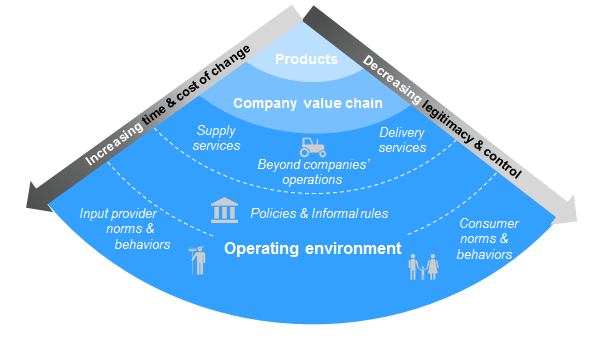Last month, we discussed the business case for gender equity and the growing momentum among corporations to create new value and capture untapped value by advancing gender equity through their core business. Companies can create shared value by advancing gender equity at 3 levels:
- Developing products and services that address the unique needs and interests of men and women
- Strengthening the supply chain by integrating and building the capacity of women-owned businesses and female entrepreneurs
- Creating an operating environment that addresses gender inequities and barriers to business growth

This figure outlines the relationship between these 3 levels and the relative time horizon associated with making change.
Products and Services
Nearly 10 years ago, Harvard Business Review published “The Female Economy,” noting that it represented a greater business opportunity than India and China combined. More recently Bloomberg estimated that women control 85 percent of all consumer purchases. Across industries, from financial service to travel, to computing, to healthcare, companies are redesigning their products to better serve women, opening up new commercial opportunities.
In financial services, Westpac has a business unit solely focused on supporting the financial needs of women in the business world. Tesla is disrupting the automotive industry by creating an SUV targeted at the practical needs of women who want easy access to third-row seats. Looking at innovation from the perspective of entrepreneurial ventures, Fast Company recognized 10 innovations that are improving women’s lives by redesigning wearable technologies, breast pumps, fashion, and health products.
Networks and intermediaries can also play a valuable role in supporting companies to innovate and explore new markets by advancing gender equity. The Global Banking Alliance (GBA) for Women, for example, plays a key role for its member banks by supporting the development and design of new financial products that consider gender-related barriers to financial products and services. The GBA fosters learning and exchange across its members by generating case studies, sharing tools and best practices, and disseminating research.
Company Value Chain
Companies have been exploring investments in women-owned businesses and capacity building for female entrepreneurs across the supply chain for years. One of the most influential companies when it comes to value chain innovation is Walmart. The company has recently committed to purchasing $20B in goods and services from women-owned businesses in the U.S. over the next 5 years. But Walmart has recognized that their own commitments are not enough to build the long-term sustainability of women-owned businesses.
In March 2017, Walmart joined an initiative of 9 corporations led by the Women’s Business Enterprise National Council (WBENC) that will publicly track and report aggregated spending on women-owned businesses. Other members include the Coca-Cola Company, ExxonMobil, General Mills, Johnson & Johnson, Procter & Gamble, PepsiCo, and Mondelez International. The tracking element of this initiative is critical. As Katherine Fritz, Genevieve Smith, and Marissa Wesely aptly note in their recent article in the Stanford Social Innovation Review:
“Companies aren’t collecting data—nor does enough research exist—to adequately back materiality arguments for gender equity across industries and the value chain. As with the environment, gathering more evidence would likely drive future private sector investment; it could encourage companies already investing in women to do more, heighten demand from investors, and encourage companies sitting on the sidelines to get involved.”
Danone is another important example of how companies can take a more holistic approach to engaging women in the value chain. In 2009, Danone created its €100 million Ecosystem Fund dedicated to supporting long-term initiatives with locally based leadership in an effort to improve social, environmental, and business impacts in those environments. There was no specific focus on gender at the outset, but through its investments, the company found that women were central to the communities in which the business operated, from farmers to micro-distributors. Each fund project tracks both social and economic KPIs, which the business uses to inform performance and impact on the business. The Danone team is continuing to learn how to improve on its approach, taking a more holistic view that considers women’s political, economic, and social position in society, as well as social pressures and women’s perceptions of themselves and what they can do.
Operating Environment
Investing in the operating environment can create long-term value by seeding the opportunities to improve gender equity and remove barriers to women’s progress. We see companies taking a stand on gender-related issues through a number of recent initiatives. Around this year’s Cannes Film Festival, for example, there was a great deal of press related to companies that have committed to the UN Women’s new initiative: the Unstereotype Alliance, which seeks to end gender stereotyping in advertising. It also happens to be good for business, as Unilever notes, “progressive adverts are 25 percent more effective and deliver better branded impact.”
In addition to signing on to initiatives and making global commitments, companies are leveraging marketing and advertising to address discriminatory social norms targeting women. We published a blog last month showing the unique power companies have to drive dialogues that can influence social norms. Unilever’s Dove brand is heralded as one of the earliest brands to address harmful norms head on—they launched their “Real Beauty” campaign in 2004. The multimedia campaign, positioned to promote new products that targeted women of different age groups, led to a significant increase in sales—sales for Dove’s firming cream, for example, doubled within a month of its launch of the campaign. Over the last 15 years, Dove has climbed to become the 7th most valuable beauty brand in the world driven in part by the loyal customer base it has built through the authenticity and positive messaging of the brand.
It is important to note that investments in shared value opportunities across these 3 levels require different expectations in terms of financial returns and social impact. For example, investments in products and services may have a shorter time horizon to showing business and social results, while investments in the operating environment may require a greater risk tolerance and patience for showing results.
Outside the examples of leading companies above, many companies tread into gender-related investments without a data-informed perspective as to what it means for the entirety of their business—internally, in terms of corporate policies and practices, as well as externally, with customers, suppliers, distribution partners and stakeholders. As a result, we see 4 steps that companies can take to best position their gender-related investments for success:
- Holistically examine the relevance of gender equity to your business. Interrogate all elements of the company—internally and externally—to better understand where competitive differentiation exists. Companies are increasingly recognizing that increasing the overall opportunities for women is good for business, but what makes the most sense for companies varies by industry, and is based on the individual strategy of any company.
- Don’t forget the data. It is critical that companies base their investments on a sound fact base, and then commit to tracking results as they would any other key business investment. For shared value strategies, we know that the positive social impact is linked to the success of the business impact, and as companies take an increasingly sophisticated look at this connection, they will be in a better position to understand how they might need to course correct their strategies to ensure they aren’t leaving value on the table.
- Partner with NGOs. NGOs can provide valuable thought partnership in the design and execution of shared value initiatives that advance gender equity. Bringing NGO partners in early to co-create efforts from the outset, can help to design efforts that are locally relevant and grounded in reliable market research. This data can help make the business case internally for investments in product design aimed at serving women’s needs. Intermediaries can also help companies investing in supply chain improvements or improving their operating environments. WeConnect, for example, has long supported women-owned businesses by building their capacity and connecting them with multinational corporate buyers.
- Embrace the complexity. Companies are only now beginning to look at how disaggregated data, social norms, and power dynamics ultimately impact the social and business results of their gender investments. It is critical to also be clear about the role of men in advancing any gender-based strategy in order to avoid unintended consequences that may actually put women at risk. The intersectionality of issues of gender and race may also be a factor that needs to be well-understood in order for a strategy to succeed. These are extremely challenging issues for any organization to tackle, but in order to capture the market opportunity, a deep understanding of these concepts will be critical.
As more companies recognize that increasing the overall opportunities for women is good for business, we look forward to partnering with leaders who are authentically engaged in this area. We welcome your feedback on additional steps that companies should consider to make the most from their gender-related shared value strategies.
If you are interested in learning more about investing in gender equity through CSR programs, join Laura Herman for an upcoming webinar with the Association of Corporate Contributions Professionals >
Learn more about FSG’s Corporate/CSR services >

